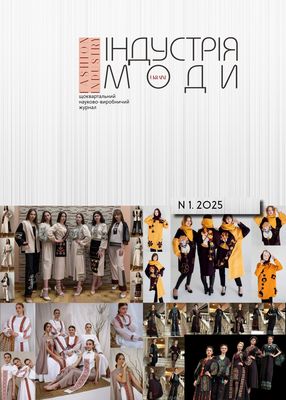FUNCTIONALITY OF SURFACTANTS IN ANTIBACTERIAL TREATMENT PROCESSES OF TEXTILE MATERIALS BASED ON COTTON- POLYESTER FIBERS
DOI:
https://doi.org/10.30857/2706-5898.2025.1.2Keywords:
coloring, dyeing, intensifier, surfactant, cotton-polyester fabricAbstract
Purpose. Theoretical justification of the use of textile auxiliarie compounds in the creation of dye nanosystems for antibacterial treatment of cotton-polyester fabrics, establishment of the influence of surfactants on the dimensional characteristics of the dye and the efficiency of dyeing textile materials
from a mixture of fibers. Methodology. Developed technologies of antibacterial treatment of cotton-polyester textile materials were implemented. Surface tension of surfactant solutions was investigated by stalagmometric method. Dimensional characteristics of dye particles were determined using the NANOSIZER nanoparticle size and zeta potential analyzer. The strength indicators of developed samples to physicochemical influences were studied in accordance with standardized methods of textile materials science. Results. The feasibility and experimentally proven functionality of surfactants in the processes of antibacterial treatment of mixed-type textile materials are characterized. The advantages are highlighted and the choice in favor of a nonionic surfactant is analyzed. The results of experimental studies of the specified samples and data on the analysis of the dimensional characteristics of the dye with the formation of nanosystems in the presence of surfactants for the antibacterial treatment of cotton-polyester textile materials are presented. The dimensional characteristics of the dye particles are experimentally determined for each concentration of surfactants and the influence of surfactants on
the production of aggregate-stable nanodispersions is established. Scientific novelty. It has been proven that nonionic surfactants contribute to the achievement of nanosized particles and effective sorption in the fiber medium of a mixed composition, taking into account the nanoscale of the dye, which is directly correlated with the uniformity, intensity, and saturation of the resulting color of the developed samples of the studied fabrics. Practical value. The use of the dye-textile material nanosystem will ensure the dyeing of textile materials of various raw material composition and fiber mixtures, which will not only reduce the temperature, but also eliminate bactericidal treatment at the final finishing stage, which will simplify the technological process, obtain special properties of the textile material, and improve the technical and economic indicators of the finished antibacterial and antimicrobial textile.
Downloads
Downloads
Published
How to Cite
Issue
Section
License
Copyright (c) 2025 Я. В. Редько, О. О. Гараніна , А. О. Варданян, Є. О. Романюк

This work is licensed under a Creative Commons Attribution-NonCommercial-NoDerivatives 4.0 International License.

